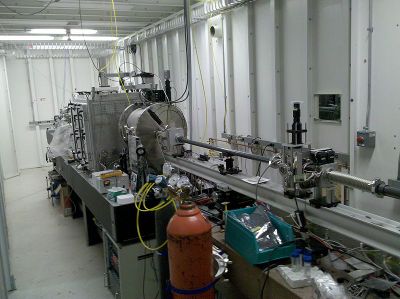X9
X9 is an x-ray scattering synchrotron beamline at the National Synchrotron Light Source (NSLS), Brookhaven National Lab (BNL). It is a joint beamline between the NSLS and the Center for Functional Nanomaterials (which is a partner user). The instrument is optimized for doing Small-Angle X-ray Scattering (SAXS) and Grazing-Incidence Small-Angle X-ray Scattering (GISAXS), as well as wide-angle Grazing-Incidence X-ray Diffraction (GID/GIXD/GIWAXS).
This beamline ceased operations in 2014, due to the transition from NSLS to NSLS-II. Improved capabilities can be found in the NSLS-II beamlines CHX, CMS, and SMI.
Contents
Capabilities
X9 can perform a variety of x-ray scattering experiments:
- SAXS and WAXS on powders or solutions in capillaries. Holder can heat from RT to 80°C.
- SAXS/WAXS (simultaneous) on proteins or other macromolecules in solution, using a full-vacuum path and a flow-through cell (for robust background subtraction).
- GISAXS and GIWAXS on thin films. Sample holder can accommodate multiple samples (for automated measurements), and can heat from RT to 220°C.
Performance
Energy range
Can perform experiments from 6 keV to 20 keV.
q-range
The instrument can capture data on both a SAXS and WAXS detector (either simultaneously or sequentially). The q-range depends on x-ray energy and the sample-detector distance. For SAXS, one can typically obtain (e.g. for 13.5 keV):
- 5.4 m: 0.002 Å−1 to 0.1 Å−1 (314 nm to 6.3 nm)
- 4.1 m: 0.005 Å−1 to 0.2 Å−1 (125 nm to 3.5 nm)
- 3.0 m: 0.004 Å−1 to 0.2 Å−1 (157 nm to 3.5 nm)
- 2.0 m: 0.010 Å−1 to 0.4 Å−1 (63 nm to 1.6 nm)
- 1.5 m: 0.011 Å−1 to 0.45 Å−1 (63 nm to 1.4 nm)
For WAXS, standard configurations yields approximately (for 13.5 keV):
- 0.235 m (sample inside chamber): 0.13 Å−1 to 4.1 Å−1 (4.8 nm to 0.15 nm)
- ~0.4 m (sample upstream of chamber): 0.15 Å−1 to 2.1 Å−1 (4.2 nm to 0.3 nm)
Resolution
- SAXS: Pixel-limited resolution at 5 m (sample-detector) is ~0.0017°, or 0.0002 Å−1 (at ~13.5 keV).
- WAXS: Pixel-limited resolution is ~0.04°, or 0.0046 Å−1 (at ~13.5 keV). Actual resolution depends on experimental setup and sample size.
Flux
- At 10 keV, flux capture by mirrors is ~2×1012 ph/s/0.01%bw
- At 10 keV, flux at sample is ~5×1011 ph/s/0.01%bw
- At 10 keV, microfocused (10 µm), flux at sample is ~2×1011 ph/s/0.01%bw
Beam Size
- TSAXS: Typical beam size is ~150 µm horizontal and ~100 µm vertical.
- GISAXS: Typical beam size is ~120 µm horizontal and ~50 µm vertical.
- Microbeam: Beam can be focused to ~15 µm (horizontal and vertical).
Detectors
Dectris Pilatus 1M (SAXS)
- Hybrid pixel detector.
- Specs
- Format: 981×1043 = 1,023,183 pixels.
- Pixel size: 172×172 µm2.
- Area: 168.7×179.4 mm2.
Mar CCD (SAXS)
- Fiber-coupled CCD detector.
- Specs
- Outputs 16-bit Grayscale TIFF files with MSB endianess.
- Pixel size (using 1024×1024 binning) is 161 μm (software says 158 um).
- Active area is 165 mm diameter.
Dectris Pilatus 300k (SAXS)
- Hybrid pixel detector.
- Specs
- Format: 487×619 = 301,453 pixels.
- Pixel size: 172×172 µm2.
- Area: 83.8×106.5 mm2.
Photonic Science (WAXS)
- Fiber-coupled CCD detector.
- Outputs 16-bit Grayscale TIFF files with MSB endianess.
- Pixel size (1042×1042): 101.7 μm.
- Detector image is 106 mm in diameter.
Access
X9 was available through NSLS or CFN user programs. However, with NSLS shutdown as of September 2014, access is no longer possible. Interested users are urged to consider the CMS beamline at NSLS-II.
Safety
Users must complete NSLS safety training, as well as receive beamline-specific training:
Users must have a valid (approved) safety approval form describing their experiment. You can check on your SAF status here:
Beamline staff must complete the following checklist before a user experiment begins:
See Also
- X9 NSLS Official Site
- Allaire, M.; Yang, L. Biomolecular solution X-ray scattering at the National Synchrotron Light Source Journal of Synchrotron Radiation, 2011, 18, 41-44. doi: 10.1107/S0909049510036022
- Yang, L. Using an in-vacuum CCD detector for simultaneous small- and wide-angle scattering at beamline X9, Journal of Synchrotron Radiation 2013, 20, 211-218. doi: 10.1107/S0909049512048984


